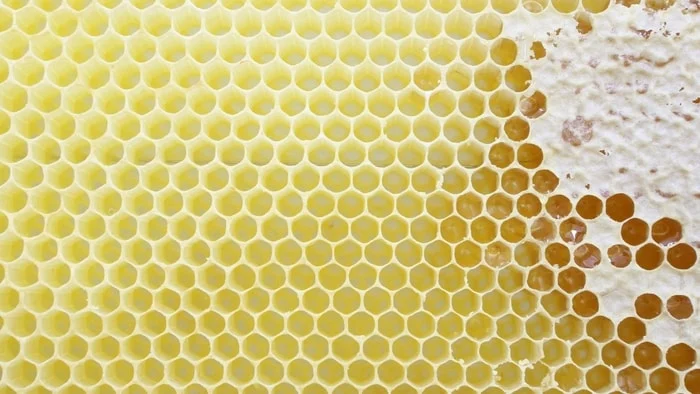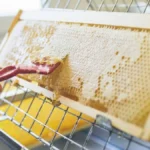In this article, we explore using beehive frames without foundation. Foundationless beekeeping refers to the method of using foundationless frames to keep bees. Bees build their own combs, to their own specifications in the frames. There are pros and cons to both foundation and foundationless beekeeping. We will explore these.
What Is Beeswax Foundation
Beeswax foundation is a sheet (which can be reinforced with plastic) of beeswax. It is placed in the middle of a frame in such a way as to employ bee space. This forces the bees to build a comb in the area we wish them to. Foundationless beekeeping refers to the method of beekeeping where we use beehive frames without foundation.

Read more about: What Does A Honey Bee Hive Look Like?
Why Try Foundationless Beekeeping
This is basically keeping bees using beehive frames without foundation sheets. In this method, we use a number of tricks to get the bees to build combs where we want them to. If the bees build across the frames there is no way to remove the combs without breaking them. This is a major disadvantage of using beehive frames without foundation.
Beeswax can be a source of contamination in your hives. Wax of unknown provenance can be a source of diseases and pesticide residues. Foundationless beekeeping seeks to reduce the risk of introducing these foreign contaminants in your hives.
Commercial beeswax often has paraffin wax, carnuba wax and other waxes added to it as adulterants.
Foundationless Frames
There are two broad categories of frames in use. Plastic ones and wooden ones. Plastic frames often have a plastic center foundation that has honeycomb patterns on it and is coated with beeswax to give the bees a hint that they can draw comb on it. These are naturally out of the equation for foundationless beekeeping.
If you look at a wooden frame, it normally has a little slot at the top into which you would insert the foundation. This is in the middle of the top bar of the frame. The foundation would then typically lie on the cross wires. These are embedded in the foundation using various methods and then we put that in the beehive and the bees make the comb. The comb is reinforced and in the right place.

Learn more about: How to Ventilate a Beehive
Option 1 Foundationless Method
If you have existing combs that have been drawn, you can put one drawn comb, one foundationless comb, one drawn comb and so on. The bees may draw the combs semi-centered in your frame using bee space. I have tried this and find they never get it quite right. When placing these slightly squonk frames in another hive the cumulative error results in a mess eventually.
Option 2 The Starter Foundationless Method
You can insert a small piece of wood in the groove. Ice cream sticks work. Dip the edge in a little dribble of beeswax, and slide these into the slot. Again, if you are lucky, the bees will get the hint and draw the frames correctly.
Option 3 Cheat Foundationless Method
I have used this method on thousands of hives. Melt some of your own wax, or some wax you trust. Get a silicon pizza mat. Dip the mat in cold water. Dip the cold mat an inch or two into the wax then dip it back in the cold water. The wax will form on the silicon and you can remove the wax coating easily.
Cut this in half and you now have two little wax strips. These can be placed into the slot in the frame so that you have a half or so inch wax strip at the top of the frame. This can be wedged in the frame with matches or toothpicks. You can bead it into the frame with a beeswax candle and drip wax into the slots to glue the wax in place.
The beeswax strips will center the bees and they will draw the combs nicely allowing you to successfully practice foundationless beekeeping.
Foundation vs Foundationless Beekeeping
Advantages
In this method, we reduce the risk of bringing pathogens and pesticides into our hive with foreign wax.
Beeswax foundation is expensive – by reducing our use of this foundation, we save money
Beeswax foundation is prescriptive – we force the bees to build the size cells that are on the foundation. Bees actually know what size cells they want, and where they want them. By playing God in a hive we can irritate them quite a bit. Let them do their own thing, make their own size cells and we may find they thrive.
Drone cells in supers – bees will often draw drone cells in the supers if we do not use foundation. This gives us a far more efficient extraction of honey, as drone cells are bigger and the honey spins out easily.
Bees may draw smaller cells than if they had foundation. Certain races of bees produce smaller bees. Smaller bees hatch a little faster, and this can reduce the number of life cycles that varroa mites can squeeze in before the bee hatches. In African bees, this is known to reduce mite numbers. This has yet to be conclusively confirmed in European bees.
Disadvantages
Mess – the bees can make a mess and you can end up with cross combs, brace combs, and a disaster in the boxes. When you end up with combs all over the place in a disordered fashion it becomes impossible to work in the hive. You may as well use a box without frames.
Loss of strength – foundation gives combs strength – when bees draw combs without foundation, you may get blowouts in the extractor a few times before the combs strengthen up enough
Brood in supers – sometimes if a queen is failing, and you are using queen excluders, you may end up with a few naughty bees developing ovaries in the supers and laying drone eggs. This results in combs that have a bit of drone brood in them. This makes extraction difficult.
We hope this article helped tempt you to try foundationless beekeeping. If you enjoyed it, please share with friends who are into low-risk, organic beekeeping and try and encourage them to try running their beehive frames without foundation as well.
Learn more about: When To Add Supers To Beehives?

Dr. Garth A. Cambray is a Canadian/South African entrepreneur and beekeeper with 28 years of experience in apiculture and specializes in adding value to honey. His Ph.D. research developed a new advanced continuous fermentation method for making mead that has resulted in a number of companies globally being able to access markets for mead. His company, Makana Meadery, exports honey mead to the USA where it is available to discerning connoisseurs. He has also developed technologies to commercially manufacture organic honey vinegar in Zambia for export globally. He holds a few patents globally in the ethanol industry and believes in technology and knowledge transfer for human development and environmental sustainability. One of his proudest achievements is the fact that the wind farm he started at one of his old apiary sites has essentially made his hometown carbon neutral.






